When I got to Lords Cricket Ground, and as soon as I'd got fixed up with where I was supposed to sleep, the first thing I asked was where you reported sick, because I'd injured my knee playing football a week or so beforehand. They sent me to a big house in Regent's Park where the Medical Centre was, where I was seen by a very austere gentleman. He greeted me with open arms and said "Oh I've been waiting for somebody like you!", and he went on to explain that he'd just concocted some sort of machine for treating these injuries, and he was waiting for a guinea pig to try it out on. And that was me.
Every afternoon I was taken into a room where I had to take off my trousers and lay on a medical couch. He strapped electrodes around my knee and switched on all sorts of gear which lined the walls, and I just had to lay there until he came back and switched them off. All I felt was a sort of tingling in the knee. It must've been successful because after about three weeks at St John's Wood, I went back to marching again. I subsequently discovered that the fellow who'd treated me was somebody called Sir Morton Smart - he was a specialist who had treated the then Prince of Wales (later Edward VIII) when he had knee troubles. So that’s my connection with Royalty - tenuous!
Obituary/some history of Sir Morton Smart: http://rheumatology.oxfordjournals.org/content/III/2/68.extract
Bridgnorth Initial Training Wing
http://www.rafbridgnorth.org.uk/indexinner.html
From there we went on to Bridgnorth which was an ITW, Initial Training Wing, where we were taught discipline - mainly marching and how to behave yourself, although we didn't all the time. One hilarious episode concerned the Orderly Officer and the Orderly Sergeant, which they have in all services.
The Sergeant comes into the Mess Hall while everybody's eating, and calls out:
"Orderly Officer - any complaints?!"
- and if anybody dares to say anything, they say it. On this particular occasion, we all looked up but carried on eating, and the Orderly Officer - a First World War Flight Lieutenant - went a bit spare:
"You come here to learn discipline, and that is not discipline! What you have to do when the orderly Sergeant says "Any complaints?" - you all sit up to attention and put your knives and forks down. And not only that, you put them down in an orderly fashion, and as you put one down you say "one" then "pause" then "two" and you put the other one down. So we'll start again."
So they both went out and came in, and the Sergeant said "Orderly Officer any complaints?", we all had to sit there and as we put the cutlery down shout "ONE - PAUSE -TWO" - which we thought was right stupid but still, there we are!
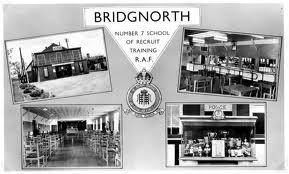
Yatesbury Wireless School
http://www.rafyatesbury.webs.com/
We were only there about four weeks before we got posted to Yatesbury, which was the wireless school. There we learnt about Morse code, what wireless sets were made of, and so on and so forth, and we did a bit of training by air experience - sending and receiving messages whilst flying. Our particular course had a civilian instructor, a fellow called Johnny Hoskins; before the war he'd been the manager of the West Ham speedway team! So that was quite something.
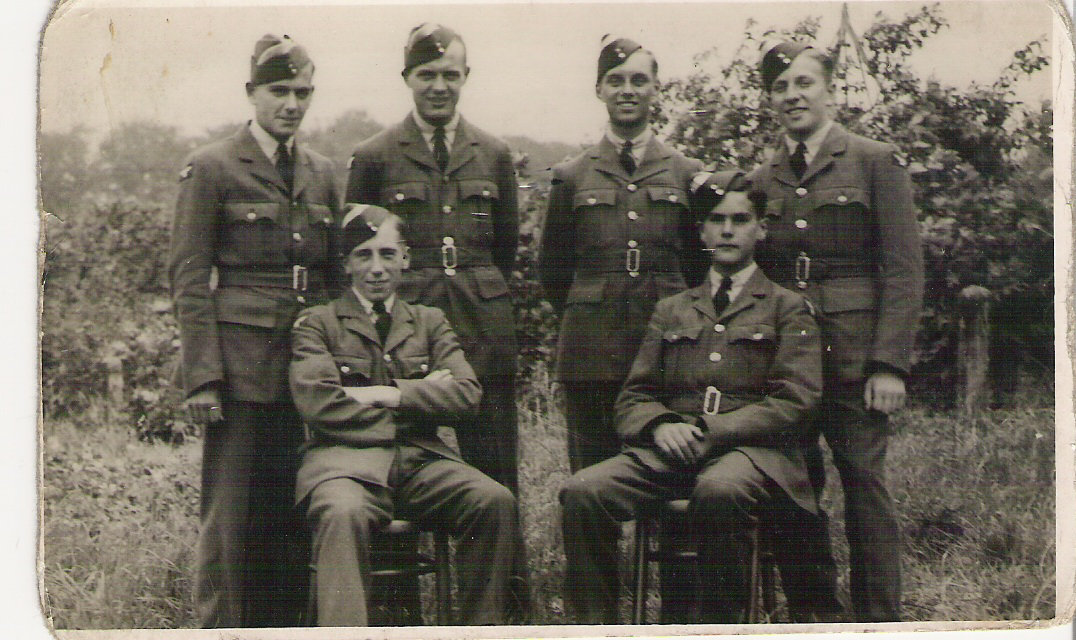
Yatesbury, 1943 - I am in the back row, second from the left. The chap on the right hand side in the back row was Horace Medlock. He was shot down and killed on his first operation. Next to him is Fred Ming, who survived the war. I met him on de-mob day.
We never got leave during this period of training, but we got fairly frequent "Friday Whiles", i.e. 48 hour passes from Saturday to Monday. You had to make your own way to/from wherever you spent this time. The common practice was to get to the main road and hitch a lift. On this occasion there were about a dozen of us all waiting when a flatbed lorry pulled up. "Anyone for London?" the driver called out. All of us raised our hands and he told us we could ride on the back, but he'd just delivered a load of cement and it was a bit dusty. We all, except one, climbed aboard.
'A bit dusty’ was the understatement of the year. By the time we were dropped off at a tube station, we all looked like ghosts. However, we managed to get cleaned up by the time we returned on Sunday night.
When we saw the 'odd man out' we asked how he had fared. "Not bad" he answered, and told us that a Rolls Royce had stopped, and the chauffeur had told him to get in the back. When he got in, he saw this austere elderly lady sitting there. It was Queen Mary, the Queen Mother.
We also did our first bit of flying, in an ancient twin-engined cabin bi-plane called a D H Dragon Rapide - the sort of thing they used to trundle passengers from Croydon over to Paris before the war. We used to go up about 12 people at a time to start with, just to fly around and come down again, without doing anything else. The plane was equipped with a bucket, and when you landed the person who'd used it last had to go round behind the hangars and empty it on the tomatoes that were growing there - it produced some beautiful specimens! I discovered that I wasn't subject to air sickness, so I never had to empty the bucket at all.
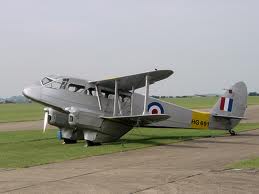
D H Dragon Rapide
Airborne wireless training was in Percival Proctors, single engine monoplanes, just the pilot and pupil. The pilots were all mad Poles. To use the radio, you had to wind out a trailing aerial. One day my pilot flew into a thundercloud (Cu Nim - Cumulo Nimbus). Proctors were not built for this treatment and we were tossed every which way, during which the trailing aerial wrapped itself round the aircraft. We were lucky to get down in one piece, with the weight on the end of the aerial bouncing on the ground behind us as we came in to land!
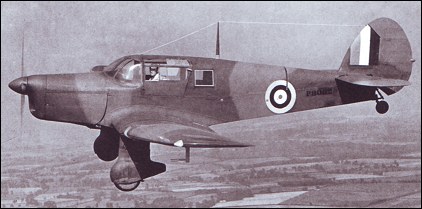
Percival Proctor
In September 1943 it was decided they were going to have a big parade in London to celebrate what they called Battle of Britain day. This was the nearest Sunday possible to the 15th, which was the day when they thought they'd shot down 185 German aircraft (although it wasn't quite that many, but they didn't know that at the time and nor did we). Yatesbury was selected to pick a squad to go, and my mate Vic Jordan and I managed to get onto the squad by nipping back up to the other end of the line after we'd been rejected several times. After extra drill practice, we were taken up to London by train and billetted again at St John's Wood, but like most other Londoners we skidaddled off back home for a while.
We got back the following morning for the parade which included marching past the Victoria and Albert memorial outside Buckingham Palace, while King George took the salute. We all had a good feed and returned to Yatesbury by train, and eventually passed out of the course. I was lucky enough to finish in the top half-dozen so I was quite pleased with myself.
At the Passing Out Parade all those who had passed lined up, and the Commanding Officer came round to shake our hands and say "well done". He handed out a set of sparks to have sewn on your sleeve, your sergeant stripes, and you were supposed to get an 'S' brevet for Signaller. Unfortunately, they hadn't had any made yet, so instead we got a Bomb-Aimer's brevet 'B', and we were instructed afterwards by the Sergeant in charge of the parade to go back to our billets and "make them B's into S's and get 'em on quick!" The best we could do was change the B into a 5 which looked a bit peculiar to start with. One or two of us had this brilliant idea that if anybody outside asked "What's that 5 for?" we'd say "Ah well, that mean's we've passed out as Pilots, Navigators, Bomb Aimers, Wireless Ops and Gunners you see, all 5!" - and some of them actually believed us!
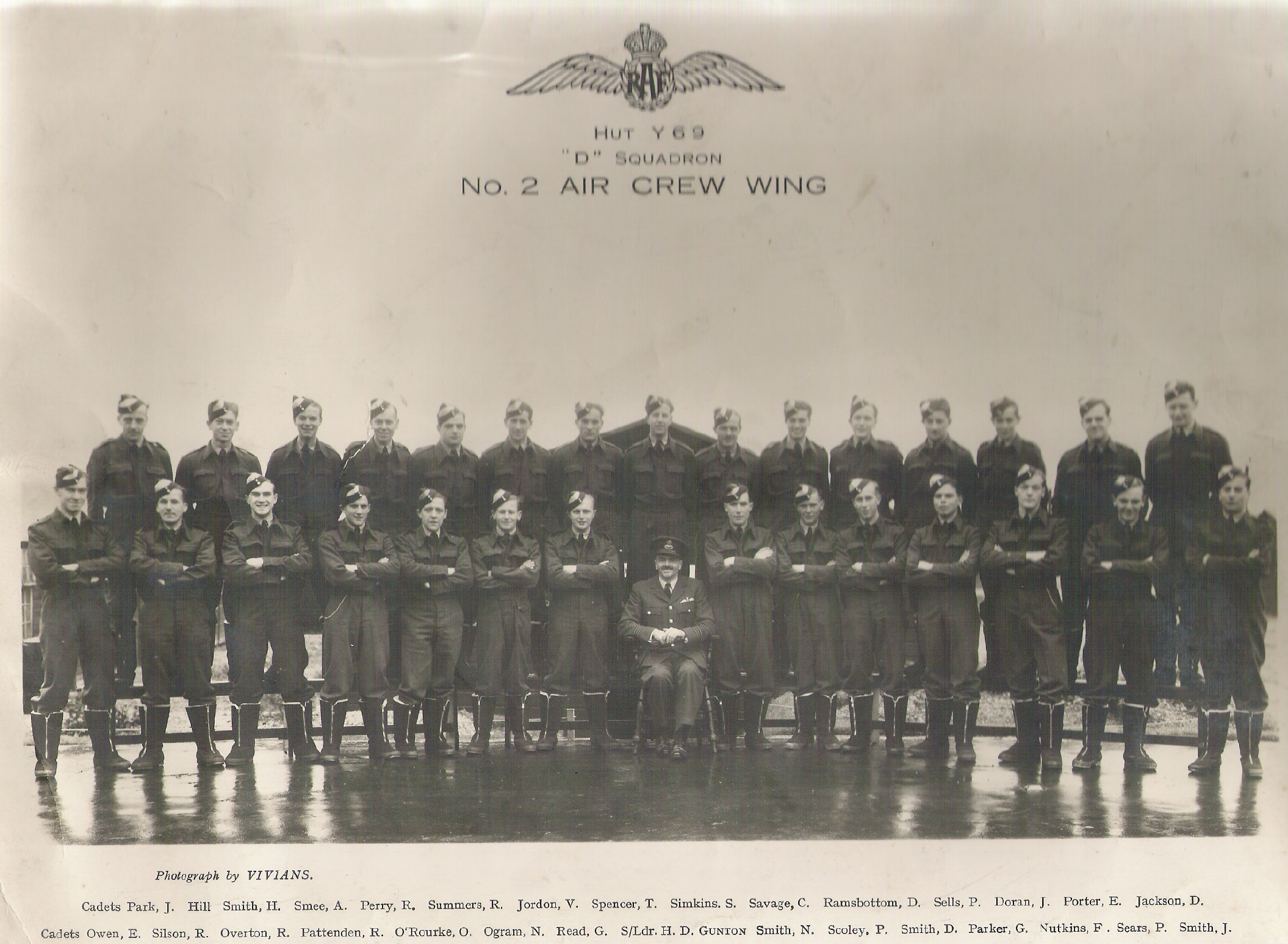
Yatesbury, Summer 1943. I am in the back row, the 7th one in counting from the right.
More Training
After a spot of leave, we had to report back to another wireless school called Madley, near Hereford. We didn't do much except hang about - no flying, just some revision and practicing on the morse key. We then got sent up to the Air Gunnery School at Castle Kennedy, a few miles short of Stranraer on the main road.
By that time it was winter of course, and it was bloody cold I can tell you! We were rationed to one bucket of fuel per hut per day, and that was for two of those little round stoves. We weren't very happy about that. We did discover though that the railway line from London to Stranraer (where you got the boat across to Ireland) was close by, through a little bit of woodland. By means of sign language we managed to convey to the various railway crews that we were bloody cold and needed something to warm us up, and it got to the stage where as they went by they hooted their whistle, and booted off lumps of coal that they already had lined up along the footplate and in the Guard's van. We would all rush out to collect them so we could get some warmth.
Another thing we used to do there was to put old fashioned ha'pennies on the line, and all put about sixpence in the kitty - then when the train had gone by, we all found our ha'pennies, and the one whose ha'penny had been squashed biggest collected the kitty.
One day we were bussed up to a place called Turnberry where there was a large swimming pool, to do dinghy drill; this consisted of stripping off to swimming trunks, then jumping in one by one to right an upside down dinghy. These had half a dozen thin ropes dangling down, there for the purposes of righting, hanging on and towing. There was already another course from another A.G. school and I recognised one of them, Claude Sole, who also lived in East Ham.
When his turn came he jumped in and disappeared under the dinghy, but after several minutes did not appear again. Without thinking I jumped in to see where he was. When I got underneath the dinghy there he was, all tangled up in the ropes. I surfaced, shouted "Help!", then went back to try to free him. A couple more also jumped in and between us we got Claude free. Typical services, we three were all told off for jumping in without permission!
And on the course we would learn about the Browning gun and all sorts of things like that, and we were taken up in old fashioned Ansons mostly, with a turret on, while some brave souls in a single-engine aircraft towed a drogue along whilst we took it in turns to fire at it. They used to dip a belt of bullets in one colour paint, like red; then another one in blue and another one in yellow, so you could have three pupils at a time taking it in turns to fire. To give you practice, they had "jams" built in; the gun would jam and you'd have to clear it. You can imagine the colour of our hands at the end of each exercise!
We also had aircraft recognition and we had quite fun, because there was one particular Corporal, who always took us, who was a bit of a big-head and thought he knew everything. One day somebody called out to him:
"Oh, what's a TR9 then Corp?"
Well, a TR9 was the old transmitter/receiver they used to use in aircraft but which had been superseded by then, but we had seen them. He replied:
"Oh yeah, it's one of them new Russian fighters, you know!" - and he wondered why we all laughed.
We all had to take an oral examination about the Browning gun, and a written examination, and of course they examined all of your aircraft firing results. Much to my surprise, I got 99% in the oral exam, as a result of which I was offered the opportunity of staying there and becoming an instructor. I turned it down for three reasons: first of all, it was too bloody cold up there for my liking; secondly, it meant being demoted from Sergeant back to Corporal (less pay); and thirdly I knew damn well that it was just sheer luck - if they'd have asked me any other of the many questions they could've done about the Browning gun I might just as well have finished up scoring nought.
From there we went on leave, and everybody was saying "thank gawd we've left that godawful place behind". The arrangement was that we'd receive telegrams telling us where and when to report next; we duly reported to King's Cross, collected our railway warrants and found we had tickets back up to Stranraer. Oh no!
Northern Ireland
We were shepherded onto one of the Irish Sea boats which cross the North Channel to Larne, in Northern Ireland. If you remember the great floods of 1953, the crossing was on the very vessel that was lost with all hands in the first hours of that storm. Even in relatively clement weather it was not a comfortable crossing - only a handful of those who boarded the boat were not seasick. I was one of them!.
So for me, the journey had meant the Underground to King's Cross, the train to Stranraer, the boat to Larne, another little train down to Belfast, then across the city on (believe it or not) a tram with all us lads on it. From there we had another railway journey south to Downpatrick; then from there to Bishops Court (which was the airfield) in these little Jaunty carts. All the drivers looked alike, with brown overcoats and green hats which were originally black!
[Jaunty or Jaunting car: a light two-wheeled one-horse car, formerly widely used in Ireland.]
We spent some time there doing a bit of air gunnery, a bit more wireless, and so on. We ate like nobody's business, because they'd forgotten all about rationing over there. Sometimes we'd hire Barney, one of the Jaunty cart drivers, who'd take us down to a place called Ardglass, where we'd go into a cafe and more or less each what you liked. While we were there Barney would be in the pub, and on the return journey he'd usually fall asleep on his seat, but the horse knew exactly where to go.
Of course we could also get eggs which we cooked on our billy cans over the stove - no shortage of fuel there! But you had to do it property - you couldn’t simply go up to one of the farms and ask for a dozen eggs, because they'd just say "what d'you think this is? - it's war time!" and shut the door on you. But if you went up to them and asked "oh, I don't suppose by any chance you have any eggs to spare would you?" they'd reply "Would you be havin’ a bag?", you'd fish out the bag you'd purposely brought and they'd say "I'll see what I can do" - and you knew damn well you'd get your dozen or half-dozen eggs, whatever you wanted.
The Suit
From there we went back home for a bit more leave. By this time my brother Dennis had been called up and was in the Fleet Air Arm. When you went on leave, you were allowed to wear ordinary civilian clothes if you wanted to, although Dennis and I only had one suit between us. However, as it was very rare that we ever got leave at the same time, whoever was home could wear The Suit.
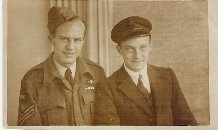
Me (left) and my brother Dennis, this photo taken in late 1945
One Saturday I was home and decided to wear The Suit to East Ham Baths where they were holding a dance, which they did about every other week (with a dance at East Ham Town Hall the other weeks). I was dancing with a girl who exclaimed" 'ere, weren't you 'ere last week?" to which I replied "No, I wasn't, but I expect the suit was!" I found out what her name was, and the next time I contacted Dennis I asked "Did you ever dance with a girl named ….” (oh, I can't even remember what her name was now), but he wrote back and said "Yes!". So it was quite amusing!
From there, we went on to OTU.